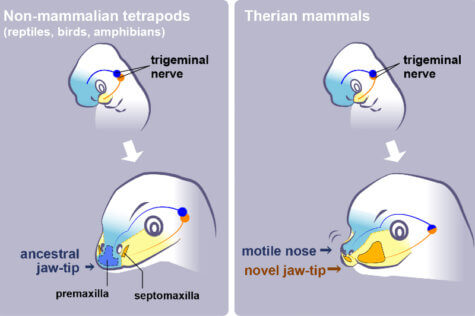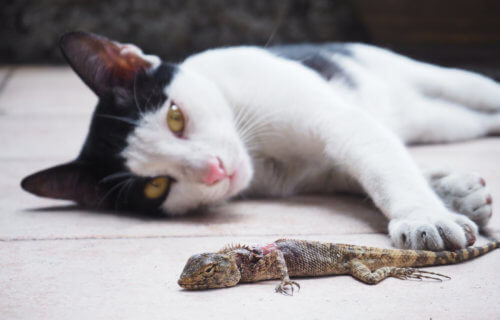TOKYO, Japan — Humans — and other mammals as well — owe their noses to the evolution of reptile jaws? Well, that’s the conclusion of an evolutionary study of animal skeletons and embryos by Japanese scientists — which discovered how mammals developed their protruding, flexible noses.
A team from the University of Tokyo also uncovered the origin of mammals’ strong sense of smell. Their findings create the potential for new animal models, like chickens or frogs, that lab experiments often use to investigate facial development disorders like cleft palate.
The traditional scientific understanding of facial evolution is that both mammalian and reptilian jaws develop in almost the same way. Even though mammals have unique noses, the evolution of their bone structure has been unclear until now.
“Existing fossils of four-legged animals, both reptilian and mammalian ancestors, have the same number of upper jawbones. It’s very easy to think that the bones are the same, but now we can study embryos and track cellular development to study these bones in much greater detail,” says postdoctoral researcher Dr. Hiroki Higashiyama in a university release.
Evolution moved the jawbone up to the nose

The study is the first of its kind to examine the evolution of facial structures using cellular studies comparing multiple embryos of multiple species to one another. Dr. Higashiyama and his colleagues worked in the lab of Prof. Hiroki Kurihara, designing experiments to track the facial development in the embryos of different bird, reptile, and mammalian species — focusing specifically on chickens, geckos, and mice.
The researchers then focused on a group of cells known as the facial prominences that are responsible for creating the physical structures of the face in the embryos. The team stained the cells in order to track them as they moved and grew to maturity.
There is a group of cells called the frontonasal prominence, which forms the tip of a reptile’s jaw, that develops into the protruding nose seen in mammals, according to the scientists.
Mammals’ jaw tips, on the other hand, come from a separate group of cells called the maxillary prominence. Using this new perspective from their experiments, the researchers moved on to examining fossilized specimens.
As species’ ancestors collected more physical and genetic differences, the bone at the tip of a reptiles’ upper jaw, known as the premaxilla, became smaller and migrated upwards, whereas the bone behind it, the septomaxilla, became larger and moved forwards to become the mammals’ jaw tip.
Mammals developed the ability to ‘sniff’
The researchers say that the facial bones of egg-laying mammals, like the Australian platypus and echidna, are living examples of how the bone structures have transitioned from the evolutionarily older reptile model to the more recently evolved mammal structure. This separation of the nose and jaw gives mammals their unique ability to “sniff,” by using muscles to flare the nostrils, deeply inhaling odors from the environment.
“This finding is a key innovation in the evolution of our and other mammals’ motile nose, which contributes to mammals’ highly sensitive sense of smell,” Dr. Higashiyama adds.
Study authors believe being able to distinguish between different odors may have helped mammals develop larger, more complex brains than earlier ancestor species. This research has provided physical evidence of the evolutionary shift in premaxilla and septomaxilla arrangements, but further research is still necessary to identify the genetic causes.
“Now we know the composition of facial prominences and embryonic development in multiple species, so we can compare facial development disorders in chickens or frogs to humans. We have mainly just improved textbook knowledge for now, but in the future, these animal models will be a practical application of our studies,” Dr. Higashiyama concludes.
Mice are currently the only animals that researchers use to study the conditions of cleft lip and cleft palate. However, they are an expensive scientific resource to maintain and, as a species, mice are slower to develop. Therefore, research into other potential animal models of facial development disorders could become a valuable research tool.
The study is published in the Proceedings of the National Academy of Sciences.
South West News Service writer Georgia Lambert contributed to this report.
